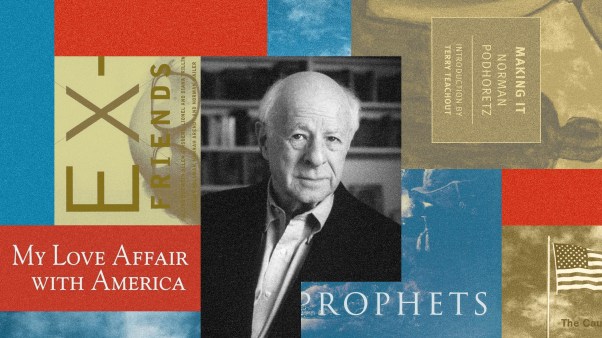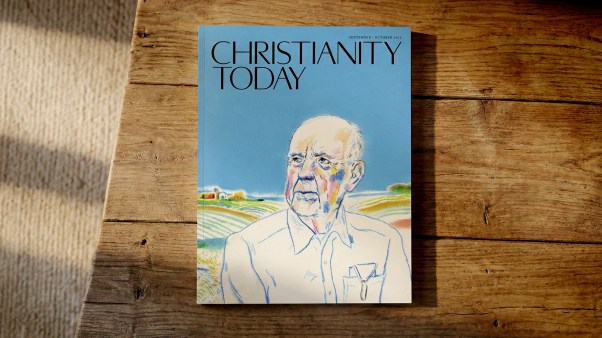Masters Of The Faerie Romance
George MacDonald, by Richard Reis (Twayne, 1972, 161 pp., $5.50), and Master of Middle-earth: The Fiction of J. R. R. Tolkien, by Paul Kocher (Houghton Mifflin, 1972, 247 pp., $5.95), are reviewed by Glenn Edward Sadler, associate professor of English, Point Loma College, San Diego, California.
Had they ever met, George MacDonald and J. R. R. Tolkien would have found they had much in common. Artistically, MacDonald’s essay on “The Fantastic Imagination” would have suited Tolkien’s well-known one “On Fairy-stories”; the two writers would have had in common the belief that goodness is greater than evil; moreover, MacDonald’s universalism would not have offended Tolkien’s Catholicism. And both, of course, wrote about “little people” and tree-spirits.
The rediscovery and increasing popularity of MacDonald’s and Tolkien’s fiction and their unique contribution to what some critics are now considering a new genre, the Faerie Romance, is the subject of these two studies by English professors Reis (Southeastern Massachusetts University) and Kocher (Stanford). Each book offers a survey narrative, at times in depth, of the writer’s theory of artistic creation (secondary world building), major philosophical and religious ideas, and moral imperatives, and an evaluation of their myth-making talents. From both an academic and a popular reader’s point of view, Kocher’s restatement of Tolkien’s blending of fantasy and reality in his epic myth of Middle-earth is superior in content and style to Reis’s thesis approach to MacDonald’s Victorian fantasies and novels.
Reis considers MacDonald to be a “time-server, one who catered to a debased popular market,” because he gave up writing romances, after the semi-failure of Phantastes (1858), and turned to “realistic” novels instead. That MacDonald continued to write fairy tales, then equally out of fashion, and put some of his best moments of fantasy in stories like At the Back of the North Wind and Sir Gibbie seems to negate somewhat any such neat classification of his fiction.
In theology, Reis finds MacDonald to be “thoroughly unorthodox and even heretically eccentric,” an adherent to a “private religion which to MacDonald was distinctly Christian.” Like other mystics before him, MacDonald followed Swedenborg and Boehme in attributing revelatory belief also to extra-biblical sources in nature, dreams, and visions, without seeing any contradiction between the Scriptures and the creative process of the imagination. Confronted as a boy by a harsh Scottish Calvinism, MacDonald moved toward universalism, trying to find a place for all living things in God’s redemptive plan. Arguing that God had made nothing in vain, he believed in the immortality of animals (in their original state) and thought that the heathen would eventually come to repentance, though Hell would exist for those who would not repent. Such beliefs lost for him his only pastorate, so he became a critic and novelist.
MacDonald’s “realistic” novels, says Reis, suffer from the faults of Victorian fiction generally: “conventional, proper, optimistic, didactic, sentimental, verbose.” In contrast, his fairy tales and romances display his genius and are his masterpieces, a view held also by C. S. Lewis and W. H. Auden. Reis’s discussion of MacDonald’s “Imaginative Fiction” and “The Symbolic Muse” in his romances are informative chapters and provide a good introductory study. But what of MacDonald’s “mythopoeic” gift? Here Reis’s study ends.
Professor Kocher begins his entertaining treatment of Middle-earth at precisely this point, showing how “the Tolkien style in creating secondary worlds did not spring full-blown,” as some say, “but developed out of his experience in writing The Hobbit.” Through the linguistic evolution of its inhabitants, and the geographical history of Middle-earth, Tolkien developed “his characteristic combination of the familiar with the unfamiliar,” his trademark thereafter.
Newly Published
Trinity Studies: Volume II, edited by Steve Anderson, Mark Asp, and Stuart Robertson (Trinity Evangelical Divinity School [Deerfield, Ill. 60015], 108 pp., $2 pb). Five articles by students and younger teachers associated with Trinity make up the second in an annual series. Included are “Women in Paul’s Life,” “Rousseau and the Defense of the Faith,” and “Titus and Corinth.”
History of Primitive Christianity, by Hans Conzelmann (Abingdon, 190 pp., $8.50). Early church history through A.D. 100. Portions of the book based on historical documents (many of which are included in the appendices) are valuable. Other portions relating more directly to Scripture interpretation are questionable. Best suited for scholars.
Is Life Worth Living?, by Floyd E. Mallott (Brethren Press [1451 Dundee Ave., Elgin, Ill. 60120], 124 pp., $4.25). An interesting introduction to Ecclesiastes. Literature teachers can find it helpful.
Many Witnesses, One Lord, by William Barclay (Baker, 128 pp., $1.50 pb). Reprint of a fine introductory book on the unity of the New Testament.
Paced by God, by Morris A. Inch (Word, 125 pp., $4.95). Deals with each man’s relation to God and man. Good material, but presupposes a flexibility and theological awareness that most of his proposed readership (evangelical youth) does not have.
Christian Deviations: The Challenge of the New Spiritual Movements, by Horton Davies (Westminster, 133 pp., $2.75 pb). A third and major revision of a popular book explaining and evaluating from a moderately orthodox standpoint ten active groups, some close to historic Christianity and others alternatives to it. Provides helpful analysis of sectarianism and direction for further reading.
The Sexual Christian, by Urban Steinmetz (Abbey, 98 pp., $1.50 pb). Frank reflections on sexuality and marriage by an unconventional Roman Catholic trying to be both realistic and faithful.
Bold Under God, by W. Phillip Keller (Moody, 141 pp., $2.95 pb). Interesting biography of Charles Bowen, missionary to western Canada.
Make the Bible Live, by Glenn O’Neal (BMH [Box 544, Winona Lake, Ind. 46590] 136 pp., $2.95 pb). Outlines preaching techniques to communicate a biblical message effectively. Seminary-level instruction.
Social Ethics Among Southern Baptists: 1917–1969, by George D. Kelsey (Scarecrow [Box 656, Metuchen, N.J. 08840], 274 pp., $7.50). An impressively broad and well researched book. Its generalizations are kept very close to the “grass roots” attitudes through the heavy use of sources such as state Baptist newspapers and convention minutes. The author retains a high degree of objectivity in covering such topics as state, war, education, prohibition, and race.
Father Coughlin, by Sheldon Marcus (Little, Brown, 317 pp., $8.95). The life of an influential Catholic, especially during the thirties. He was a fighter for the common man but also an archetype of the right-wing “Christian” ideologue and a master of the mass media. Worthwhile for the political education of Christians on a very practical level.
Mystery, Magic, and Miracle: Religion in a Post-Aquarian Age, edited by Edward F. Heenan (Prentice-Hall, 180 pp., $5.95). Very interesting analysis of religion today and its various manifestations. Includes interviews and firsthand reports, such as Satanist Anton LaVey’s testimony and Timothy Leary’s first published description of LSD-induced religious experience.
Genesis: A Commentary, by Gerhard von Rad (Westminster, 440 pages, $8.50). Translated from the German, a thoroughly revised edition of a major scholarly commentary.
Power, Greed, and Stupidity in the Mental Health Racket, by Walter Fisher, Joseph Mehr, and Philip Truckenbrod (Westminster, 173 pp., $5.95). Not the muckraking attack implied by the title, but still critical of the entire Freudian-hospital-disease-cure model on which most mental-health institutions are based. Suggests the significant limitations of psychoanalytic counseling, especially in institutional settings.
The Great Church-State Fraud, by C. Stanley Lowell (Luce, 224 pp., $7.50). Documents the growing cycle of church-state cooperation, breaching traditional constitutional separation, and suggests some dangers of this trend. A valuable book in this area. Lowell is editor of the magazine Church and State.
Jesus in Bad Company, by Adolf Holl (Holt, Rinehart & Winston, 157 pp., $5.95). An attempt to separate the true Jesus from the image of him carried in traditional language and thought forms. Jesus is depicted more as a model for starting the journey toward true knowledge. A European best-seller.
Beyond Science, by Denis Alexander (Holman, 222 pp., $4.95). A research biochemist offers a lucid, non-technical presentation of the nature of scientific thinking and the state of scientific research today, with a well-argued case for Christian theism.
Church and Power in Brazil, by Charles Antoine (Orbis, 275 pp., $4.95 pb). A well written history of the Roman Catholic Church in Brazil, primarily 1963–69. Grapples with the significant question of the social message of the church in a nation and era of totalitarian practices and massive social inequities. The diversity of theological frameworks represented by different socially active groups in the church blurs any answers offered in this book.
A New Joy, by Colleen Townsend Evans (Revell, 124 pp., $3.95). The author, a former film actress who is the wife of the new minister of Washington, D. C.’s prominent National Presbyterian Church, writes with homey insight on applications of the Beatitudes to women.
Religion and Society in England: 1790–1850, by W. R. Ward (Schocken, 330 pp., $10). An interesting history of the period. Outlines a general pattern of dissenting religious movements, their subsequent establishment and elevation from the masses, followed by another subsequent cycle of undenominational dissent. Book should be valuable to the historically inclined. Style sometimes tends to confuse.
The Backside of Satan, by Morris Cerullo (Creation House, 224 pp., $4.95). Cerullo means well and has written a fairly good book in the anti-occult category. However, in so doing he has tended to add to the glamour and mystique of the occult world. Not recommended except to mature Christians, who probably do not need it.
God’s Joyful People: One in the Spirit, by Oswald Hoffmann (Concordia, 103 pp., $1.50 pb). Clear, concise discussion of the doctrine of the church, “the living organism of God’s living people, wherever they may be.” Well suited for the young or untrained Christian.
You Can Understand the Bible: By Its Unifying Themes, by Nelson B. Baker (Holman, 144 pp., $2.95 pb). An outline of the consistent themes that run through what often seems to be the diverse material in the Bible. Emphasizes God’s people, their inheritance, and the means of man’s restoration to God and to his inheritance. With questions for each chapter and an easy reading level, the book is well suited for instruction of untrained Christians.
Having explicated Tolkien’s theory of the function of fantasy, Kocher sets out on a provocative Tolkienish quest. Especially arresting is his chapter on “The Free People” (elves, dwarves, ents, and men) in the trilogy, and of “Aragorn,” the shadowy judicial king. Kocher’s depiction of the inner life of Middle-earth discloses much of contemporary interest that even the careful reader might miss in the story. Graphically we see the materialism, grinding mechanism, and lust after “no-death” that rots out Gondor and its people: a “frantic search for more life took varying forms”—elixirs, horoscopes, tombs instead of palaces, and a decrease in childbirth. Is this not the beginning—in the Third Age—of the depressive state we find our own primary world in today?
Kocher’s most original contribution to Tolkien studies is a chapter on Tolkien’s longer narrative poems, light verse, and shorter fiction: “Leaf by Niggle” and “Smith of Wootton Major,” in which Kocher finds autobiographical “glimpses” of Tolkien’s vision of youth and old age, remind us of MacDonald’s “The Golden Key,” Phantastes and Lilith, and of Novalis’s famous dictum: “Our life is no dream; but it ought to become one, and perhaps will.” In such a dream-world MacDonald and Tolkien share much. How much perhaps only they themselves can finally tell.
Gimmicks Not Needed
Where Was the Church When the Youth Exploded?, by D. Stuart Briscoe (Zondervan, 1972, 128 pp., $.95 pb), is reviewed by Roy C. Price, pastor, Christian and Missionary Alliance Church, Wadsworth, Ohio.
To have a significant ministry with today’s youth doesn’t require a lot of new program gimmicks. It demands that we get back to the hard-rock basics of discipleship.
Briscoe speaks from experience on both sides of the Atlantic and as an evangelist and pastor. He asks the frightened adult, “Why fight what you don’t understand? You may even find yourself fighting something valid, hindering something progressive, and blocking a development that time will prove to be the right one.”
The author tells of his first personal confrontation with youth at “The Cat’s Whisker,” a coffeehouse in England. A dynamic speaker, he was in demand across the country. But each night hundreds of young people aimlessly passed time at this coffeehouse across the street from his home. Through the needling of his conscience he gathered courage to talk with them.
This clean-cut ex-marine with a banking career was flatly told by one youth that “ ‘if you really believed what you say you believe, you would have been down here before tonight to tell us’.… So I went home a very quiet and troubled young man; troubled because of the inconsistency of my profession.… Since that time I have been less apt to criticize the young people of today and more anxious to understand them.”
Understand them he seems to as he talks about “Grass, Speed and Peer Fear”; “Infection, Detection and Conception”; “The Beatles, the Stones and the Rev. John Newton”; “The Long, the Short and the Hairy.” He discusses the causes of rebellion, Woodstock, and the occult and suggests how all these reveal youth’s search for spiritual reality.
When he gets to the churches, Briscoe finds a reactionary attitude desiring to preserve the old ways, lacking in compassion, incapable of communicating with the young. Young people are indifferent toward the churches because of their own ignorance, their impatience in wanting instant change, and the churches’ seeming irrelevance to real life. Basic to the churches’ failure is the inability to produce youth who have disciplined lives.
As a Britisher come to America, Briscoe detects “signs of boredom among many of the American church’s young people that frighten me.” The two problems facing the churches are the unreached kids outside and the bored kids inside. “The unreached kids are unreached because the bored kids are bored.… Set the ‘bored’ kids to reach the ‘unreached’.… Not only will the ‘unreached’ be reached, but the ‘bored’ kids will have no time to be bored.”
Once kids are actively witnessing to their peers, they will be motivated to undergo training to help them become more effective. This will require the youth worker to spend much of his time with the “nucleus” who are willing to be disciplined and be aggressive, rather than waste time entertaining the large numbers, which is not the church’s objective in the first place.
Briscoe’s first chapter contrasts in short lines the worlds of youth and the institutional church. The last chapter portrays the union of adult and youth in him who is above, through, and in all.
In The Journals
The Evangelical Committee for Urban Ministers—ECUMB (383 Shawmut Ave., Boston, Mass. 20118) publishes Inside, a fifty-page journal appearing every other month. The first issue of 1973 included an article by Leighton Ford on “Crisis and Change” and articles on competition. The second issue was devoted to Israel and tried to convey something of Arab viewpoints. A subscription to Inside brings with it a similar journal in size, frequency, and concern called The Other Side. The advisory board of the latter includes Senator Mark Hatfield, evangelist Myron Augsburger, and theologian Vernon Grounds. The first issue this year had several articles on Paul’s social ethics, and the second issue focused on congregations. A year’s subscription to both journals (twelve issues) costs $6.










